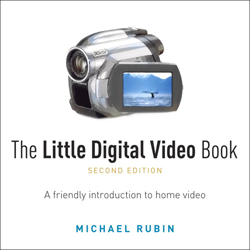
The Little Digital Video Book.
by Michael Rubin
Peachpit Press
ISBN 978-0-321-57262-1 224 pages paperback
Price: $24.99 US
When it comes to getting a digital video camera, you typically come about it in one of two ways. Either someone gave it to you as a gift, or you just bought it because your old one just broke. But in both cases, you probably obtained it just a few short days before you actually need to use it. Sadly, these cameras are a bit more complex than you typically expect, and you are not going to have those 3 to 4 weeks you need to figure out how it works. So what do you do?
Oh sure, you can crack open the well written user manual…. OK, so they are not so well written, typically translated directly from a foreign language, and do nothing to help you actually shoot video. Now what? You go and get this book, The Little Digital Video Book, Second Edition by Michael Rubin (there is no relation), you sit down and spend a few hours reading the 215 pages, seven chapters of useful info, and doing the assignments at the end of each chapter, and you will be up and running on no time. Because that is what this book is all about, getting you up to speed quickly in preparing, shooting, editing, and finishing your video.
Here is a quick look at what you can expect to find in each chapter:
Chapter 1, “The Basics”
If you recently bought a new camera, you may wish you had read this first, because this lists a lot of good tips and things to look for in a new camera. It also covers editing, and what tools you will want to have on hand. Of course, those of us with Macs already know our choices for editing tools. And if you have a good camera, then this chapter will just convince you you were right.
Chapter 2, “Your Camera”
This is just the low level stuff, things you can do with most camcorders, and how to use each function. My favorite part is the blindfold test.
Basically, you will learn to completely work your camera in the dark, which is important, as it makes sure you know it well when the time comes to use it. They will also teach you about logging and labeling your tapes. I have a big stack of unlabeled tapes, and have no idea what is on them. It will also talk about time-codes, those silly little numbers you see go by, and what to do with them. Yes, they are useful!
Chapter 3, “Shooting”
OK, now you are comfortable with your camera, it is loaded up and ready to do, so lets shoot something. This chapter covers concepts and definitions associated with shooting video and editing it. It also helps you understand and prepare for what you will need on a shoot. You will learn coverage, point-of-view, top-down, framing, building a shot, depth of field, long vs. short shot, the wide shot, and many more techniques, and how to use them all properly. The basics of lighting and sound will also be covered, and there are assignments to help make sure you understood the info.
Chapter 4, “Organizing Your Video”
What you shoot is as important as how you shoot it. And so is organizing your materials. Rather than spend time searching for the things you need when that shot is ready, you will learn how to organize it all in advance, and have it ready to go. More details on labeling and logging will be covered, as well as the use of a log book.
Chapter 5, “Getting Ready to Edit”
OK, now you have a bunch of video. Now what. Shooting is the easy part, but editing correctly is hard. This chapter helps make that easier by taking you through some basic facts and fundamentals on editing, including hard disk requirements, cabling, and hooking it all up. This also covers building your “editing bay”, and what you will need to do it right.
Chapter 6, “Editing”
To quote the author, “Editing is where it all comes together…” After all the work above, what your final video looks like will actually depend on how well you can edit it. This chapter covers approaches to editing, working with sound, creating master tapes, and using titles and special effects in your video. Examples use Final Cut Express, so Mac users should be happy!
Chapter 7, “Finishing Up”
The final chapter in this book gives some ideas of what to do with your video. It talks about compressed video and the possible formats you can use. It covers making DVDs to posting on the Internet (YouTube), and even a bit about copyright law. Lastly, it covers deleting files and cleaning up, a step most of us just forget.
I’ve been shooting video for a long time, and I still liked this book as I learned a lot of new things. It was simple and direct, and covered not only the basics, but tips and instructions on making better video. It is good for the beginner or expert alike. I plan to read it again, and this time, I may actually do all the assignments! If you own a video camera, or are thinking about getting one, this $25 is well worth the investment.
email – MyMac Magazine – Twitter – Advertise – Reviews Archive – Podcast

Leave a Reply
You must be logged in to post a comment.